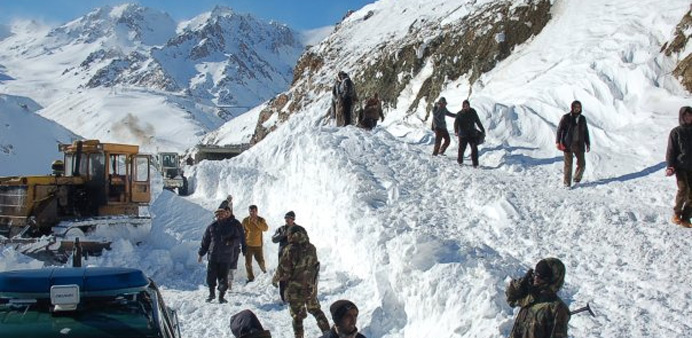AFP/ Kabul
Avalanches triggered by heavy snow have killed more than 100 people in mountainous areas of Afghanistan and the death toll is expected to rise, officials said on Wednesday.
Most of the victims were in Panjshir province north of the capital Kabul, where 95 bodies were recovered according to acting governor Abdul Rahman Kabiri.
The avalanches after two days of heavy snow destroyed more than 100 homes in the province and blocked main roads, making it difficult for rescue workers to reach the stricken villages.
"Ordinary people and government employees are using shovels and bare hands to rescue those who are still trapped under the snow," Kabiri said.
The death toll could rise unless the central government and relief organisations sent emergency assistance soon, he warned.
Twenty-nine people were suffering from frostbite and other injuries, the acting governor said.
The toll was confirmed by Abdul Rahman Kalantari, head of disaster response at the Afghan Red Crescent Society, who said they had already dispatched health teams to Panjshir.
A further 11 people were killed in the provinces of Bamyan, Badghis, Nangarhar and Laghman, officials said.
Deadly avalanches are common in Afghanistan's mountainous areas in winter. One in the remote far northeast in 2012 left 145 people missing, presumed dead.
The country has had a largely mild and dry winter, but large parts of the north experienced heavy snowfall over the last 48 hours.
Parts of the capital Kabul were hit by power cuts on Tuesday and Wednesday after snowstorms and avalanches damaged power cables in the Salang Pass, which links the city to the country's north.
The pass remained closed to traffic on Wednesday.
Despite the billions of dollars in aid from the international community after the collapse of the Taliban in 2001, Afghanistan remains among the world's poorest nations after decades of conflict.
Rescue efforts after disasters such as avalanches and flash floods, which often hit as snows melt in the spring, are frequently hampered by lack of equipment.
Poor infrastructure makes it difficult for rescue teams to reach isolated areas.

